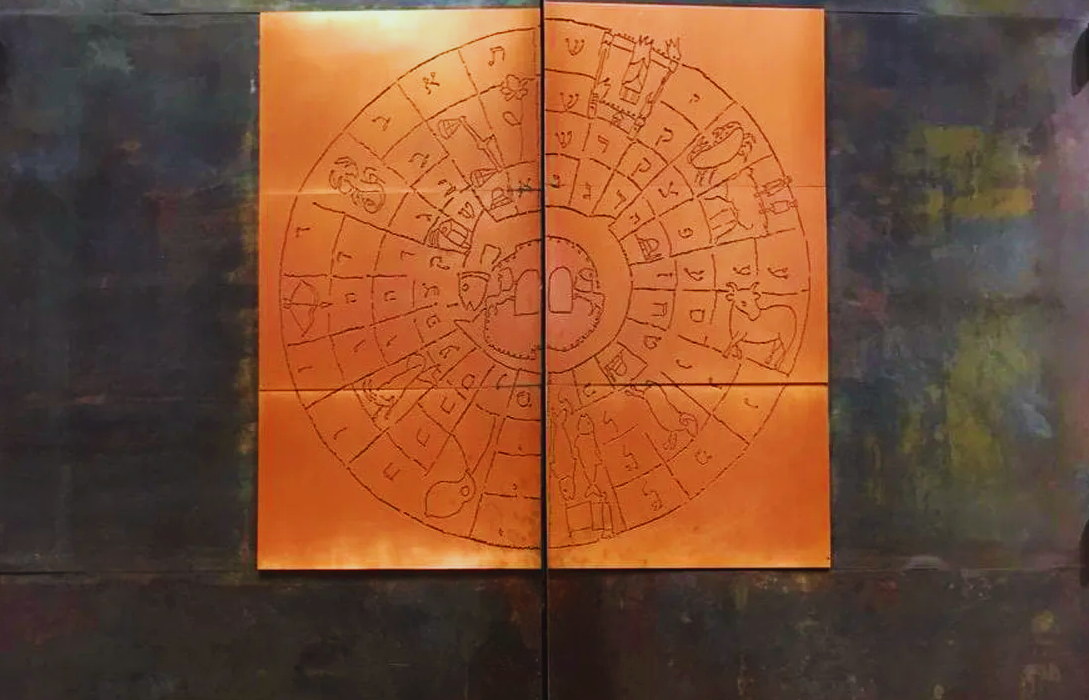The rabbis’ ambivalence towards astrology–their knowledge of and participation in it even as they denied its relevance–belies the place of astrological figures as a central motif of the synagogue of the talmudic period. The prevalence of the zodiac in synagogue art is described by Bernard Goldman in his discussion of the fifth or sixth century C.E. mosaic zodiac preserved in the Beth Alpha synagogue:
Goldman’s Description
“The badly preserved mosaic floor of the synagogue at Yafia contains an animal circle, similar to that of Beth Alpha, but it is not clear whether it represents the zodiac or the Twelve Tribes. The synagogue of ‘Ain Doug (Na’arah) contains an elaborately decorated mosaic floor with the wheel of the zodiac holding the center of the tripartite panel, much as at Beth Alpha; but, at ‘Ain Doug an interlocking pattern containing animal and floral vignettes replaces the Akedah.
In 1930, another synagogue mosaic containing the zodiac was uncovered on Mt. Carmel at the village of ‘Isfiya (Esfiya). Also, some of the relief decoration from the synagogue at Beth She’arim may have composed a zodiac design. The most recently discovered zodiac floor mosaic is one near Tiberias that also repeats the Beth Alpha format but, in style, is far closer to its classical art sources. There are several other probable references to the zodiac in synagogue architectural decorations; for example it is found on a fragmentary carved screen from Rafid. There is no question that future excavations will bring to light additional examples.”
The Use of the Zodiac
The recurrence of the zodiac in synagogue after synagogue suggests its importance as more than a decorative or ornamental device. Rather, as the talmudic sources make clear and as the continued appearance of the zodiac in later European Jewish art shows, the use of the zodiac in the synagogue of the rabbinic period was consonant with its symbolic importance, an importance that extended from non-Jewish into Jewish metaphysics.

Help us keep Jewish knowledge accessible to millions of people around the world.
Your donation to My Jewish Learning fuels endless journeys of Jewish discovery. With your help, My Jewish Learning can continue to provide nonstop opportunities for learning, connection and growth.
In classical sources, the zodiac symbolized the heavens. Through the image of the zodiac “the artist transformed the starry path into a canopy, dome, arch, and frame to express the cosmic dimensions of the icon and ritual it enclosed (Goldman, p. 61).” Expressing this meaning, the zodiac had a natural place as a focal point of Jewish worship and ritual, as a “symbol of the heavens and constellations under whose aegis the destinies of nations and of men were ordered (p. 64).”
Prayers for divine protection, for God’s mercy and forgiveness from sin, for the coming of salvation appropriately were recited in a setting that depicted the divine and heavenly forces that could answer those prayers. Astrological symbols thus functioned in ancient synagogues not as mere ornamentation but as vivid representations of the Hellenized Jews’ perception of the cosmic order.
A Change in Practice
At the center of the representation of the zodiac at Beth Alpha, as in the fourth century floor at Harnat, Tiberias, and elsewhere, stood the sun-god Helios and his chariot. Despite the firm biblical, post-biblical, and rabbinic literary traditions against the creation of images of what is on earth, let alone of foreign deities or of the invisible God of the Israelites, it seems almost certain that those who worshipped in these synagogues knew exactly what this portrayal of Helios symbolized.
As E.R. Goodenough states, in their eyes this was “the divine charioteer of Hellenized Judaism, God himself,” the God at whom all prayer and supplication was aimed.
The medium of astrology and the symbols of the zodiac thus portrayed for the common Jew of the talmudic period the cosmic order and the deity who had created that order and, with it, the entire world. This was the true God who responded to human prayer, controlling and shaping in the manner that astrology describes all that happens on earth.
Reprinted with permission of The Continuum International Publishing Group from The Encyclopedia of Judaism, edited by Jacob Neusner, Alan Avery-Peck, and William Scott Green.

